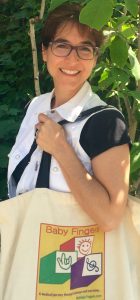
Lora Heller of BABY FINGERS
By Claudie Benjamin
When Lora Heller’s two sons who are now in their early 20s were only six months old, they were using American Sign Language to communicate. Neither one was Deaf or hard of hearing, but as a board-certified music therapist with a master’s degree in Deaf education, Lora was interested in starting early to encourage her own children’s communication and language acquisition.
Typically, children only start approximating individual words when they are between eight months and 12 months, with two-word phrases appearing between 18 – 24 months. However, by 10 months of age, Lora’s sons could put two words together, like “more milk” by gesturing with the fingertips of both hands meeting meaning “more” and clenching a fist as if milking a cow, meaning “milk.” Her sons’ experience is shared by most of the babies six months and older who come to classes taught by Lora and her team. Classes for adolescents and adults are also offered. Baby Fingers programs are open to students who are hearing or deaf and courses taught online include music and/or ASL for students of all ages with and without disabilities, hearing and deaf. Adult ASL classes are taught by Deaf instructors. In discussing deafness, Lora says that when spelled with a capital D, it refers to people who use ASL and identify as a member of the Deaf community, a cultural identity. When spelled with a lowercase d, it refers to the overall medical diagnosis of deafness regardless of the cause (deaf or hard of hearing at birth, deaf due to illness or trauma, late or gradual hearing loss).
Lora had a strong interest in working with deaf students after being a summer camp counselor and coming to know an 11-year-old camper who was Deaf. Once completing her professional education in music therapy and Deaf studies she decided to combine the two disciplines for hearing and non-hearing students.
She explains also that American Sign language is its own language thereby leading to bilingualism, and that remarkably, it can serve as a bridge in a household where two languages are spoken; a “sign” can be understood by all family members and can assist a child to develop stronger connections leading to fluency in both spoken languages.
Music is the way that most new signs are introduced at Baby Fingers. Watching videos Lora has posted illustrates adorable young children happily forming signs for specific words. The videos also convey the fun and playfulness that is integrated into the learning sessions. Children attend with a parent or caregiver and there is lots of warm encouragement. Familiar music, often accompanied by Lora playing her guitar, including huge baby and toddler favorites like the exuberant “Baby Shark” are taught along with songs written by Lora and her team. Parents mostly hear about Baby Fingers by word of mouth or via social media. Some are concerned that their child has failed a hearing test. Others, knowing early communication is possible before a child communicates in words, want to support this ability. And hearing parents of Deaf children can find additional support in this program. Lora has written Sign Language ABC and Sign Language for Kids on her approach to language acquisition for young children, which she says may be helpful for home use by families interested in practicing what they learn in the onsite or virtual sessions hosted by Baby Fingers. Their YouTube channel, BabyFingersASL, is another resource for families.
Baby Fingers classes are taught at the Prenatal Yoga Center, 141 West 72nd Street, in various other Manhattan locations, and at sites in other boroughs. Virtual programming begun during the pandemic attracted parents from across NYC and from different parts of the country and this programming will continue in both onsite (1:1 and for groups of 4-12 students) and in remote formats. More information is at www.mybabyfingers.com, or email info@mybabyfingers.com
